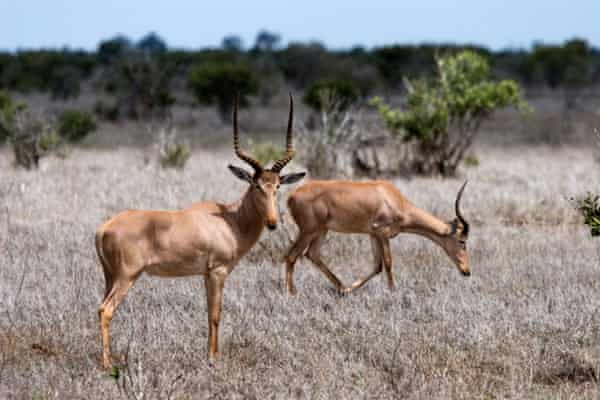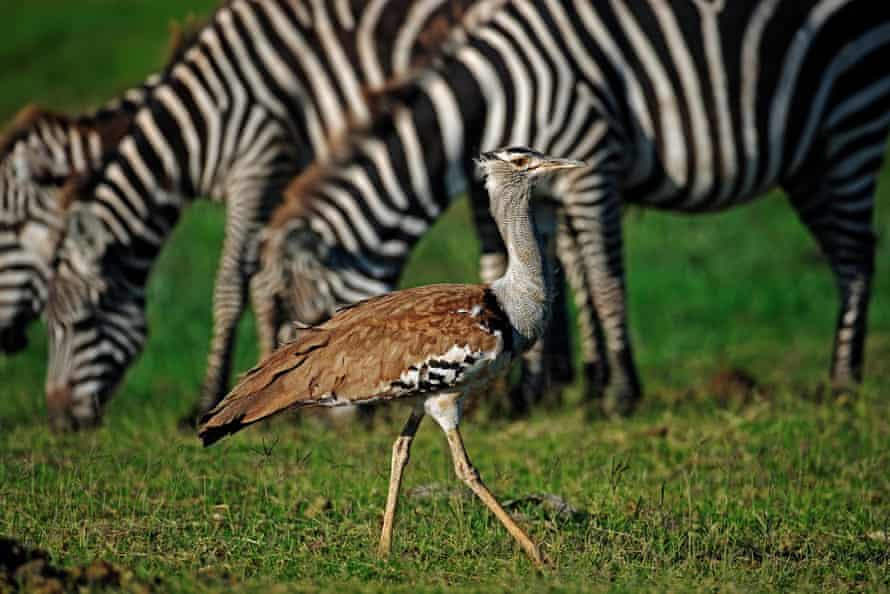Planes, helicopters, boats and 4x4s are being deployed, hundreds of camera traps and satellite collars monitored, and an array of dung studied across Kenya, as the country embarks on its first national census of wildlife.
The census, covering the country’s 58 national parks and reserves, private and community conservancies, is due to be completed by the end of July. It will cost 250m Kenyan shillings (GBP1.6m) and includes a count of terrestrial and marine mammals, key birds such as ostriches and kori bustards, and endangered primates. The results are expected in August.
The aim of the count is to establish a baseline of wildlife status and distribution to inform policy direction. The country’s tourism and wildlife cabinet secretary, Najib Balala, said the census would also recommend modern strategies for effective wildlife conservation and management. while monitoring the number and distribution of rare and threatened species such as pangolins and green and hawksbill turtles, whose numbers are in decline because of intense poaching.

While the country has conducted targeted counts for endangered animals such as elephants and rhinos, there has been little monitoring of other rare, endangered and threatened species “whose numbers and range have significantly declined in the past three decades”, the government says. These include rare antelope species, including the sable, sitatunga, hirola and mountain bongo. The mountain bongo and hirola are listed by the International Union for Conservation of Nature as “critically endangered”.
According to the brief, key wildlife landscapes in Kenya have experienced challenges in terms of land tenure and its use, drought and the climate crisis, factors “likely to impact negatively on the wildlife population for certain species”.
“It is therefore important to undertake this national survey to establish a baseline data on wildlife population status and distribution for future use, to understand wildlife population trends and shifts in their distribution. We also need to know if any given area has the carrying capacity for particular animals, and the effects climate change and increase in human population have on wildlife conservation,” said Balala.
Balala said the count would also help mitigate rising cases of human-wildlife conflicts and reduce a mounting compensation bill, now standing at 14bn Kenyan shillings.
Ground and aerial techniques are being used to count large mammals in the open savannah, arid and semi-arid areas, while camera traps and dung counts are being used in forested ecosystems.

Dr Patrick Omondi, acting director of the newly formed Wildlife Research and Training Institute, said the government was using “internationally recognised peer-review methodologies” to arrive at accurate data.
“Deployment of personnel and equipment depends on the size of a conservation area,” he said. “For example, we deployed a team of 50 and 13 aircraft, both fixed and helicopters, in the Tsavo ecosystem, the country’s largest. Other methods include using satellite collars, especially for migratory animals, to prevent double counts. Aerial voice recorders are also being used to analyse the presence of specific animals in any given area.
“In forested areas, we have set up camera traps to count nocturnal animals such as pangolins. This will be the first time that an African country is counting the number of pangolins, which are currently the world’s most trafficked animals. Aerial surveys will also be used for big marine life including whales, sharks, dugongs and sea turtles.”
Dr Paula Kahumbu, head of conservation body WildlifeDirect, said if the census was conducted well, it would reveal the ecological emergency facing protected areas that affects not only the animals but the lives and livelihoods of millions of Kenyans.
But, she added: “The count alone is not enough. The census should report on the status of land and habitats, which are the critical life support system for the animals. The integrity of Kenya’s protected areas is being impacted by developments like roads and railways, hotels and military camps, which affect animal movements.

“In addition, habitat quality, such as frequent forest and bush fires, excessive livestock grazing in parks, forest destruction, sand harvesting and destructive fishing practices reduce biodiversity, besides creating fertile grounds for the rapid spread of invasive species.”
Kahumbu said even numbers of animals once thought of as “common”, such as wildebeest, had plummeted by up to 90% in the Nairobi, Narok and Amboseli ecosystems, mainly due to habitat loss.
The 2020-30 management plan for Nairobi national park shows the collapse of a wildebeest migration that numbered 30,000 animals in the 1960s “with a mere 200 currently using the park”. The report also details a 70% decline in warthog, waterbuck, hartebeest and gazelle populations.
According to the government report, corridors that once linked the park to the greater plains were obstructed by development, urban sprawl and subdivision, or blocked by fences.
“Our parks, reserves, forests and conservancies are Kenya’s life-support system. They provide water, generate power, clean the air and provide resilience to the climate crisis and extreme weather conditions. Since they cannot exist as islands, urgent legislation is required to secure buffer zones, wildlife corridors and dispersal areas,” Kahumbu said.
Jagi Gakunju, a conservationist and tour operator in Masai Mara, said the exercise would be more successful if the government tapped into wildlife data collected by the numerous conservation bodies operating in Kenya.

Most private and community-based wildlife conservancies, he said, had been conducting their own censuses over the years, making their input vital.
“Nature Kenya, for example, is the local partner of BirdLife International and has invaluable data on birdlife, and so do other conservation bodies whose statistics feed into global databases. It would be good to review such data and determine how the current way of counting wildlife differs from what has been done in the past. The current exercise ought to be a buildup of the past initiatives,” said Gakunju.
Cynthia Moss, the US-born conservationist whose organisation Amboseli Trust for Elephants has been conducting the world’s longest research on elephants, said her organisation was willing to share data collected over nearly 50 years.
“I think the initiative is good for conservation,” she told the Guardian over the phone. “We have accumulated a lot of information over the years and are willing to share, should the authorities require it. In any case, the government has more resources than private conservationists.”
Find more age of extinction coverage here, and follow biodiversity reporters Phoebe Weston and Patrick Greenfield on Twitter for all the latest news and features